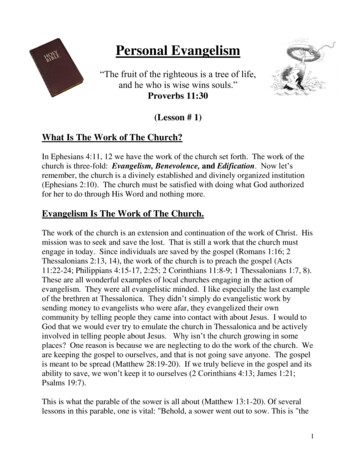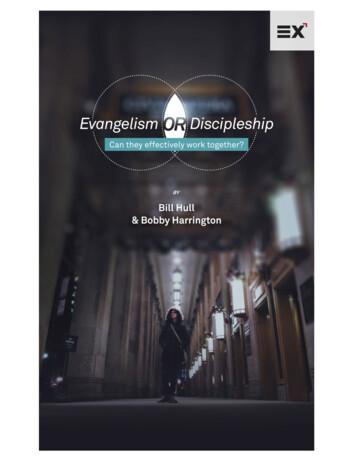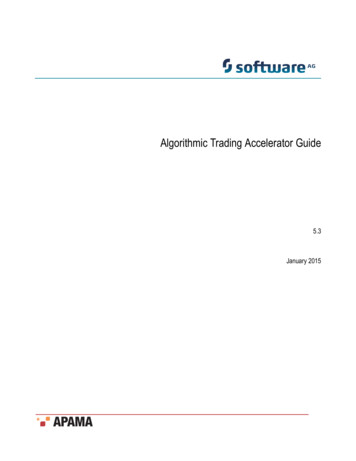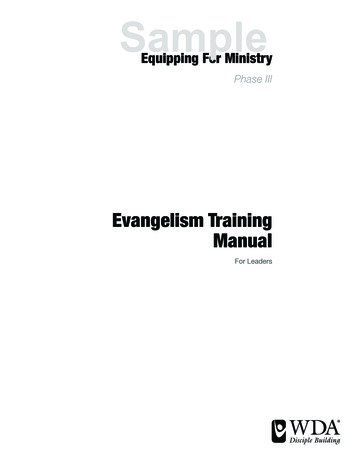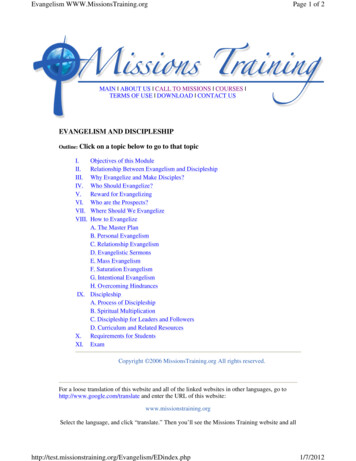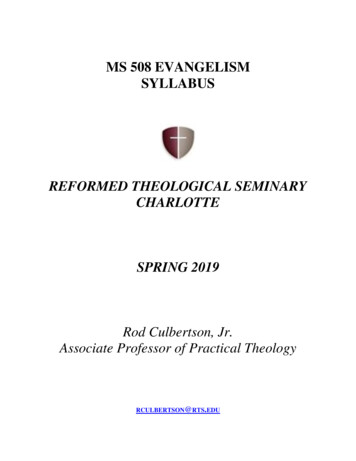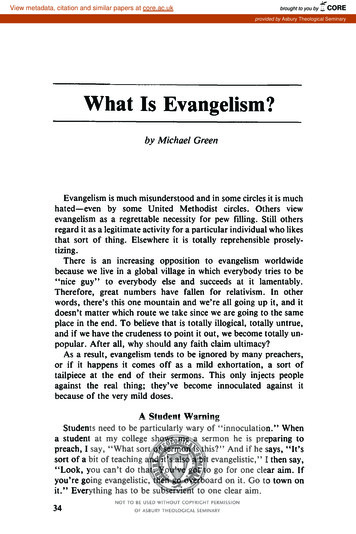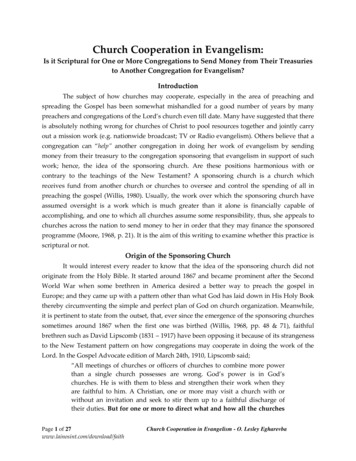
Transcription
ChurchEvangelismAcceleratorYour Personal Evangelism AssistantTim Gentry
ContentsMY316 Church Evangelism Accelerator83 Factors111 Focus236 Functions27The Disciple-Making Process33Questions to Guide the Development of a Disciple-Making Process43Evaluate your Current Ministries: Disciple-Making Process Matrix45Develop a Disciple-Making Process Symbol48Vital Behaviors for Evangelism51Baptism Goal Service54MY316 Church Evangelism Planning Calendar55Evangelistic Best Practices59Getting it Done Timeline62MY316 Evangelism Resources65Evangelism Resources74
We proclaim him, admonishing and teaching everyone with allwisdom, so that we may present everyone perfect in Christ.–Colossians 1:28 (NIV84)Is evangelism a priority in your process?It always takes more effort to lead someone to Christ than most every otherspiritual activity. As you take up the challenge of this manual to developyour church’s disciple-making process, make sure that you give priority intime and resources to evangelism.Colossians 1:28 is a wonderful goal for pastors and church leaders, buthow are you doing? More specifically:Are you making disciples?The goal for this book is to accelerate your church’s evangelism effortsby helping you identify and develop a clear disciple-making process withevangelism as its core.It is a given that your desire as pastor is to fulfill the Great Commission.You will be urged to develop a symbol that embodies yourThat is the purpose of the Church, the core of your calling into ministry.process. This symbol will help you communicate your church’s disciple-However, when was the last time you asked yourself the question, “Am Imaking vision, add structure to your efforts and evaluate your successesmaking disciples? Am I leading my church to make disciples?”and challenges.How do you know?There are anecdotal stories that you can tell of a few individuals whoUltimately, this book seeks to help you connect the dots between yourmany valuable church efforts and your primary responsibility of makingdisciples in fulfillment of the Great Commission.have made significant steps in maturity with Christ. But across the life ofyour congregation, how do you really know if you are actually fulfilling theReady to press the gas pedal?Great Commission?Have you defined what a disciple looks like?In order to be able to measure something you need to be able to define it.Once defined, a disciple can be measured, evaluated and corrected.Do you have a disciple-making process in place?The church body can likewise be measured, evaluated and correctedthrough a disciple-making process. A spiritual process can be developedthat identifies the key benchmarks of a healthy, growing follower of Christ.6 //// 7
MY316 ChurchEvangelismAcceleratorTo accelerate your church evangelism process, consider MY316. Justas MY316 evangelism resources use John 3:16 as a Biblical basis and asystem (3 people to pray for, 1 thing you will do – share your story, 6 waysyou will serve them), so MY316 Church Evangelism Accelerator employs316 as a system:3 SynchronizeScheduleBudgetDollarsStewardship1 FocusCommitment of Pastor6 ryFellowship8 //// 9
33 factors //PeopleCalendarBudget
33 Factors //PeopleToday, it makes sense to use different methods for different folks.The message stays the same, but the methods are personalized forthe prospects.StructureOne thing you and your congregation do not have as much is time. Yes,there are still twenty-four hours in a day and seven days in a week. ButInvestthe time demands on families are greater today. Along the same line asMotiveslead your congregation to prioritize the church’s activities. Pay attentionHave you ever sat down prayerfully and allowed the Holy Spirit toto activities that are a duplication of the disciple-making process youdiscern your motives for reaching people and adding members to yourdevelop. You will need to answer the questions, “Is it wise to expect peoplecongregation? A common sign on church buses says, “Come grow withto participate in two or three worship services that are very similar?” “Ifus.” What does that mean? Why would someone want to attend yourpeople are expected to attend multiple meetings at the church building,church to help your church become bigger?when will they have time to minister out in the community?”methods, do you have one time that fits all?In the exercises that follow, you will be given the opportunity toTry to keep this practical and do not over-spiritualize this point. Yes,The goal here is to streamline the physical structure (schedule) ofyou are to gather people together to glorify God. Yet on another level youyour congregation to encourage people to move through the disciple-are to be “admonishing and teaching everyone with all wisdom, so thatmaking process with steps that are what Andy Stanley calls easy, strategic[you] may present everyone perfect in Christ” (Colossians 1:28 NIV84). It isand obvious.easier and wiser to invest in the lives of people than to invest into the lifeof an organization.MethodsResource: Seven Practices of Effective Ministry by AndyStanley. practicallyspeaking.orgThere was a time when your community was homogeneous and resourceswere limited. It was good stewardship to use one proven method to reacheveryone. Today, your community is diverse and though you may not haveall the resources you want, you have more resources and access to moreresources than in the past.12 // 3 Fact ors3 Fac t ors / / 1 3
enlist Elmer Towns – 435-592-3338, elmertowns.com/spiritual gifts testPrayer Ministry Insights – 480-951-9888, Gary Smalley – hen he said to his disciples, “The harvest is plentiful but theworkers are few. Ask the Lord of the harvest, therefore, to sendout workers into his harvest field.”–Matthew 9:37–38 (NIV84)Individual assessmentAssessment is where the church affirms what individuals have found aboutthemselves in the spiritual gift discovery step. This is a key step to bringobjectivity to what can be a subjective exercise. Prayer and discernmentAs the spiritual leader in God’s local church, you have to decide if youby spiritually mature Christians can play an important role for an individualreally believe that God is in charge and if He is faithful to fulfill His promises.in discovering God’s will for service.Specific, personal prayer for workers is key to the local church fulfilling theGreat Commission.Remember, God has no commitment to provide workers for yourPersonal invitationThe influence of the pastor from the pulpit is significant. But when itkingdom, but for His own kingdom and for His own reputation, He iscomes to enlisting people, there is no substitute for a one-on-one personaltotally committed.invitation. When prayer to “ask the Lord of the harvest, therefore, to sendSpiritual gift discoveryThere are several surveys available that cover spiritual gifts, talents andout workers into his harvest field” (Matthew 9:38 NIV84) has been claimedand church members know their spiritual gifts and talents, then they areready to volunteer for significant ministry responsibilities.temperaments. When used in a process of assessment through the localAndy Anderson, who was a Sunday school expert and who developedchurch, these surveys can be effective in highlighting areas of interest andthe Growth Spiral, noted that churches often “enlist [their] problems.”fruitfulness in ministry. These surveys are not the final word themselves,Have you ever approached someone with the fearful plea of “You are mybut help give direction to God’s design for each individual believer.last hope. Anyone can do this job. Would you please help me out?” Don’tyou believe God can honor words of faith, such as: “I have given this muchBelow are several helpful surveys: LifeWay – 800-458-2772, lifeway.com/lwc/files/lwcF MYCS 030526 Spiritual Gifts Survey.pdf Church Growth Institute – 800-553-4769,churchgrowth.org/analysis/intro.php14 // 3 Fact orsprayer. After considering your spiritual gifts and talents, I believe you arethe person for this significant ministry. Would you please give this mattersome prayer and let me know next week what you believe the Lord wouldhave you do? Also, the church will provide you with the training neededfor this ministry.”3 Fac t ors / / 1 5
Specialized trainingSpecific, personal, exceptional training is the missing ingredient togrowing mature followers of Christ. The desire to accomplish a task isempower with variousevangelism stylesessential, but applying yourself to training is the step that will ensure theend result is fruitful.Meaningful ministryAll these are the work of one and the same Spirit, and he givesthem to each one, just as he determines.–1 Corinthians 12:11 (NIV84)Nursery worker. Sunday school teacher. Usher. If these are the first ministrypositions you think of for your church, then you are not challenging yourFrom my experience, only a small portion of church members will becomepeople to serve Christ, reach the world and make disciples. These positionsinvolved in a confrontational, cold-turkey evangelism approach. With yourare important, but can’t you believe the creative God of this universe alsoblessing, many more of your members can become active soul-winnershas many other ministries ready to be discovered to honor Him and touchby recognizing, mobilizing and training for various evangelism styles, suchyour community?as outlined below.Peter’s Confrontational ApproachThis is the most common style used in churches today. In this method,individuals directly confront other individuals with the gospel truths. A wellknown example of Peter’s approach can be seen in Matthew 16:16 wherehe declared that Jesus was the Messiah.Paul’s Intellectual ApproachThis is also a common style, but normally regulated to scholarly debates. Inthis approach, individuals appeal to another person’s intellect, stimulatinghis or her interest in spiritual truths. A clear example of this approach isseen in Paul’s discussion with the Athenians in Acts 17.Blind man’s Testimonial ApproachThe testimonial approach, which employs the sharing of one’s personalexperiences, is a regular element in the confrontational approach, butstill deserves to be identified separately. We can pick out many examples16 // 3 Fact ors3 Fac t ors / / 1 7
in the Bible of this approach, but one of the most famous is in John 9.The blind man refused to engage in the intellectual approach and simplystated, “I was blind and now I can see!”Matthew’s Interpersonal ApproachWe remember each of the Bible stories about Matthew, the tax collector,and yet it is easy to forget them when we try to train others in evangelism.In Luke 5, we see where Matthew held a banquet and invited all of hisfriends (or at least the people that wanted to come) to hear the One thathe had decided to follow.Samaritan Woman’s Invitational Approach33 Factors //CalendarPrioritizeIf you have unlimited building space, workers and time then you cancontinue with business as usual. But if you are short in any of theseareas there is a need to prioritize. Prioritizing means freeing yourIn John 4, you are familiar with the unlikely Samaritan woman that invitesbuilding space, workers and time for the key steps in your church’sher village out to hear the One who told her everything she ever did.disciple-making process.This approach is used more than we think. The key is to highlightit and integrate it into the special events and ministries held throughoutthe year.Dorca’s Service ApproachIn Acts 9:36, Dorca is identified as “always doing good and helping thepoor.” Although service is a common gift among church members, it is notalways connected clearly to sharing the gospel. By teaching that serviceis a key ingredient in sharing the gospel, you can empower servers andbetter plan to use it in outreach activities.Resources:SynchronizeDo you find that multiple ministries want to use the same rooms at thesame time? Synchronizing considers the needs, space and times so thatyou can optimize your resources. This allows you to track what rooms arebeing used by specific ministries at what times.ScheduleOnce you have prioritized and synchronized, then you are ready to scheduleout current ministries and be ready for future activities. This allows you toplan the best use of your facilities and have a heads-up on future needs. Becoming a Contagious Christian, Bill Hybels and Mark Mittelberg Building a Contagious Church, Mark Mittelberg The Master Plan of Evangelism, Robert E. Coleman18 // 3 Fact ors3 Fac t ors / / 1 9
33 Factors //BudgetDollarsResources: Great Commission Budgeting, Stewardship DevelopmentAssociation – Bob Shelton, bshelton@bgco.org, 405-942-3000, 4561 Practical Ideas (For a two year stewardshippromotion) – SDA – Bob Shelton Building a Church Budget Bridge for theKingdom, SDA – Bob Shelton �Your checkbook is a key indicator of your spiritual maturity and whatyou value.” How many times have you made a statement like this in astewardship sermon or Bible study? Likewise, if an objective, outsideobserver looked at your church’s budget, what would he or sheidentify as the church’s priority? Would it be making disciples? Would itbe evangelism?Following the exercises described later in this manual, you will beable to lead your church in identifying and/or building a disciple-makingprocess. The knowledge and enthusiasm for this process will provide theatmosphere for shifting dollars to high priority ministries.StewardshipNot only do you need to reprioritize money within the church’s budget,you need to increase the budget to support the outreach and discipleshipministries that the Lord will put on your heart.20 // 3 Fact ors“Ask the Lord of theharvest, therefore, tosend out workers intohis harvest field.”–Matthew 9:37–383 Fac t ors / / 2 1
11 focus //Commitmentof Pastor
11 focus //CommitmentOf pastorDo you believe God wants yourchurch to make disciples?This is a difficult question to ask and to answer. How can any pastor notbelieve that God wants his church to make disciples? Mentally, you affirmthis. But emotionally and physically, do you make choices every day andfollow through on them to faithfully train your church members to grow inthe grace and knowledge of Christ and to equip them to do the work ofthe ministry?Are you willing to work tofacilitate that process?This is the natural follow-up question to the one listed above. Do you catchyourself coasting? Are you settling for second best in the effort that youare giving God in your church and ministry setting?Resources: Breaking the 125 Barrier, Nelson Searcy; Breakingthe 250 Barrier, Nelson Searcy; and Breaking the 500Barrier, Nelson Searcy. churchleaderinsights.com Renovation of the Heart, Dallas Willard24 // 1 Focus“We proclaim him,admonishing andteaching everyone withall wisdom, so that wemay present everyoneperfect in Christ.”–Colossians 1:28
66 Functions wship
6Evangelism does not happen in a vacuum. Thus, the significance of6 functions //identifying or developing the disciple-making process is included in thischurch evangelism accelerator. Just as significant, it is important thatevangelism has an identifiable step in the disciple-making process. Thecelebration of conversion is baptism, but there are steps leading up to thebaptism and following after.I identify six functions of the church. These can be seen as stages in thedisciple-making process.Discipleship“Therefore go and make disciples of all nations, baptizing them inPrayerthe name of the Father and of the Son and of the Holy Spirit, andteaching them to obey everything I have commanded you. AndDo not be anxious about anything, but in everything, by prayersurely I am with you always, to the very end of the age.”–Matthew 28:19-20 (NIV84)and petition, with thanksgiving, present your requests to God.And the peace of God, which transcends all understanding, willguard your hearts and your minds in Christ Jesus.–Philippians 4:6-7 (NIV84)Fulfilling the Great Commission is the purpose of every believer and thelocal church. It is important to ensure that discipleship does not becomea tired cliché or an obvious assumption in the church. Having a clearPrayer is the lifeline of a personal relationship with Jesus Christ. Likedisciple-making process ensures that the activities and resources of theevangelism, it is easy to say that prayer is a given in everything that achurch are following and supporting the purpose of Jesus Christ’s bride.Christian and a church does. However, it deserves to be put front andcenter in the functions of a church and the personal life of a discipleof Christ.WorshipGod is spirit, and his worshipers must worship in spiritEVANGELISMand in truth.–John 4:24 (NIV84)“Come, follow me,” Jesus said, “and I will make youWorship is the most identifiable function of the church. Again, it is easy tofishers of men.”–Matthew 4:19 (NIV84)28 // 6 Functionssay that many of the things the church does has to do with worship. But6 Fun ct i on s / / 2 9
specifically laying out activities that focus on this function provides forof the members while still acknowledging this is only one of the aspectseffective and excellent worship of our God.of church life.MinistryResources: 360-Degree Preaching, Michael J. Quicke“For even the Son of Man did not come to be served, but to Future Worship, Lamar Boschmanserve, and to give his life as a ransom for many.”–Mark 10:45 (NIV84)Ministry is service. That is a simple concept, but enlisting, training andmobilizing believers is a challenge. Giving thought to each of thesefunctions and picturing them in a process helps prioritize the resources(workers, time, money, space and calendar) of the church. This can makesure that the functions happen in a natural sequence and that the churchdoesn’t become weighted too much in one particular function.FellowshipAnd let us consider how we may spur one another on towardlove and good deeds. Let us not give up meeting together,as some are in the habit of doing, but let us encourage oneanother—and all the more as you see the Day approaching.–Hebrews 9:24-25 (NIV84)Fellowship is more than a potluck. Fellowship involves being in communitywith one another where you genuinely take an interest in the lives ofothers. Fellowship involves handling conflict in the biblical manner ofMatthew 18. Recognizing fellowship as a specific function of the churchallows leadership to develop meaningful activities that invest in the lives30 // 6 Functions“ Let us encourageone another—and allthe more as you seethe Day approaching.”–Hebrews 9:24–25
The discipleMakingprocess
The DiscipleMaking processdevelopment processes listed below and see if any resonate with yourheart and ministry situation.LifeWayLifeWay.comThrough the next pages of this accelerator, consider these six steps todeveloping a disciple-making process for your church.LifeWay’s LifeSpan Spiritual Development primarily relates to curriculum1. Prayerfully ask the Lord’s leadership in this process.that addresses the stages of spiritual development. It could be described2. Enlist several church leaders to walkas a spiritual taxonomy. Though more classroom based, this system canthrough this process with you.3. Consider the disciple-making processes listed in thisguide (as well as others) and identify the key steps youeasily be used to develop church ministries. It accounts for all of the stagesof development except pre-conversion. This system is broken down inmore detail that can be found on LifeWay’s website.want to highlight. If you have trouble on this step, I wouldrecommend using the six functions mentioned.4. Answer honestly the questions listed later in thisguide about your current process (or lack of one)and the process you would like to see instead.5. Complete the Disciple-Making Matrixwith your church leadership.6. Develop a symbol that represents your disciplemaking process. This is key for prioritizing,communicating and evaluating your process.Think of the life of a person from birth to the grave. There are physical,emotional and mental stages of development. The same is true in thespiritual life. The writer of Hebrews (5:11–14) challenged the believers thatinstead of growing into teachers they were still spiritual infants. Beloware several spiritual maturity development charts to consider indeveloping your church’s disciple-making process. Note the spiritual34 // t he discip l e -Mak ing P ro c e s st h e di s ci ple-Mak i n g P roces s / / 3 5
Jim Putman: Real Life MinistriesRick Warren: The baseball diamondDerivation from: Copyright 2010 Jim Putman. All rights om. Real-Life Discipleship Training Manual /Rick Warren’s baseball diamond is one of the most famous disciple-makingISBN 978-1-61521-559-1process symbols today. Though many know Saddleback Church for itsReal-Life Discipleship process begins with pre-conversion and continuescontemporary worship, its heart is a system of encouraging members andthrough spiritual maturity. It uses family relational figures (infant, children,prospects to identify where they are in their spiritual journey and the nextyoung adult and parent) but only for description. It uses four trackssteps needed. The baseball bases are well known, but the marks of aof descriptions (from the inner circle to the outer) that are helpful indisciple are found as one drills down at each base.Share theGospelnAgainer Release tlooneakiple AMDisclepciSYo hareurLifeShDeadLanguage/BehaviorsCharacterized by:Self-CenterednessChu ltilMisterEquip forMinistrymt theConnec osepto Pur36 // t he discip l e -Mak ing P ro c e s stoinnnCo allSm (FaMtu ininit stries yecntevid orPro ppOiTraeG ctm rou toily p)AddrngenYouoto dRelease tryMinisLanguage/BehaviorsCharacterized ge/BehaviorsCharacterized by:IgnoranceCo nneto Go ctdLanguage/BehaviorsCharacterized fnttanInfExplaDiscipl inesProce hipssReleasetobeaRelAn Dis eaoYo th cur eBortose le thip wir lpHewNeerear Sha TruthDisunderstanding the suggested steps.nCont h e di s ci ple-Mak i n g P roces s / / 3 7
ENGEL’S SCALE OF LOSTNESSGod’s RoleAdapted from James F. Engel and Wilbert Norton, What’s Gone Wrong WithWitness’sRoleMan’s Response-10*Listen-9*Dialogue-8Awareness of a supreme being but noknowledge of the gospelgives another way of seeing the progression that most people make inWitness-7Initial awareness of the gospelcoming to know Jesus Christ and then growing in maturity with Him. AsSpeak-6Awareness of the fundamentalsof the gospelEvangelize-5Grasp of the implicationsof the gospelProclaim-4Positive attitude towardthe gospelTeach-3Personal problem recognition-2Decision to act-1Repentance and faith in Christthe Harvest? (Grand Rapids: The Zondervan Corporation, 1975), p. 45By its title, you can see that Engle’s Scale is not a system. However, ityou think of these steps, can you classify any of them into larger steps thatConvictioncan form the basis for your church’s disciple-making ionNew Creation in Christ 1Post-decision evaluationFollow-up 2Incorporation into the bodyCultivation 3Conceptual and behavioral growthNurture 4Communion with God 5Reproduction of ministry: internally, withinthe body using spiritual gifts; externally, tothe world as witness and servantEternity38 // t he discip l e -Mak ing P ro c e s st h e di s ci ple-Mak i n g P roces s / / 3 9
MasterLife5C’s of Missional GroupsMasterBuilderbgco.org/5csThe Bible says that there is nothing new under the sun. MasterLife hasBob Mayfield, BGCO Sunday School and Adult Specialist, hasbeen around for a long time and the principles it communicates anddeveloped the 5C’s of Missional Groups. Though small group focused,teaches have been around even longer. MasterBuilder, like Real LifeBob’s C’s identify steps for a follower of Christ to take that lead toDiscipleship above, gives you several layers of description for thetransformational change. Note the individual symbols that support eachdevelopment of a disciple.of the components. These symbols help communicate each componentWitnessGODParent 1 Cor 3:1-3highlight the purpose of ministries and activities.Servant Steward Encourager1 Cor 3:5–61 Cor 4:11 Cor 3:10–161 Cor 3:7–91 Cor 4:6–17Spirthese disciple-making processes. Some of the stages even identifyrrecharacteristics or behaviors for that particular LeadNote the stages of spiritual development that are identified inbo-laerevelibUnTASKS 1 Cor 1:181 Cor nd can be used as map keys in the bulletin, website and newsletter toCONNECTMASTERBUILDEREvangelism Follow-up NEEDTraining Equipping Supporting1VISIONCONSECRATECONTENTCHANGECAUSE40 // t he discip l e -Mak ing P ro c e s st h e di s ci ple-Mak i n g P roces s / / 4 1
Each of the previous symbols and systems are presented so thatyou can see how the disciple-making process can be seen from differentperspectives. Hopefully, one of these will be used by the Holy Spirit togive you wisdom and discernment as you lead your congregation indevelopment of your own clear disciple-making process.Questions to Guide theDevelopment of aDisciple-making processThough each church’s mission is the same (Great Commission), eachchurch has a different culture. Consider the following questions whencrafting your unique strategy: How would you explain the big picture of disciplemaking through your church as it is now? How do you and your church leaders define a“disciple”? “Disciple-making or discipleship”? If a new guest walked into your door, what is that person’s firststep to start the process of disciple-making? What is the purposeof this step? What is the desired outcome for that step? What steps should be taken before that person walks into your door? How easy is it for that person to understand thatfirst step? How will he or she know about it? What is the next step for that new guest? What is thepurpose of this step? What is the desired outcome?How does he or she know what this step is? Additional questions for each step: How would you title eachstep? How do you symbolize each step? What does the title/symbol say about what is expected? What person or groupleads each step? What is God’s role in each step?42 // t he discip l e -Mak ing P ro c e s st h e di s ci ple-Mak i n g P roces s / / 4 3
In your structure, how many steps do you envision arenecessary for the new person to complete the process?How do you know when it is time for a new step? Howdo you know when the process is complete? Can any of these steps be combined intogroups for a common symbol?evaluate your currentMinistries: discipleMaking process matrix As you lay out each step, what do you see missing?The Disciple-Making Process Matrix (see a sample matrix and a blankYou can use a table similar to this one to guide the development of yourmatrix on the next pages) is another tool to test the balance of yourdisciple-making process:church’s ministry. In this exercise you gather your church’s leadership toStepTitle/SymbolPurposeDesiredOutcomeWho isresponsible?How will theparticipantknow about it?prayerfully consider evaluating how well you are making disciples.This matrix can be printed out for individuals, but it works best ifcompleted on a whiteboard or chalkboard so that everyone can viewit together.Across the top list the four, five or six basic catagories of your disciplemaking process. There are six functions already suggested on this matrix.Then place your church activities down the left-hand side. This can befilled out in advance, but it is good to involve your leaders by asking themto suggest activities to be placed in this column.Place a number from 1–5 with 5 being the highest under each churchfunction that is accomplished by the activity. Note the totals of eachcolumn. Do you see any patterns? Where is the focus of your church’sactivities? Is there balance in your disciple-making process?An additional step you can take is to identify if the focus of each ministryResources: Advanced Strategic Planning, Aubrey Malphursactivity is inward or outward. To do this, write “inward” or “outward” in theappropriate column on the right-hand side.There should be lively discussion during this exercise. Under the Total Church Life, Darrell Robinsonleadership of the Holy Spirit, eyes will open to the aspirational values of The Purpose Driven Church, Rick Warrenthe church verses the actual values.44 // t he discip l e -Mak ing P ro c e s st h e di s ci ple-Mak i n g P roces s / / 4 5
InwardInwardInwardOutwardInwardInwardInward22 in6 PrimaryFocusAdapted by Tom Belew from Aubrey Malphurs, Advanced Strategic Planning46 // t he discip l e -Mak ing P ro c e s sPrayerFellowship5Ministry4Disciple-Making Process MatrixWorshipDiscipleshipAudio VisualAWANABaptismBenevolent FundBudget/FinanceBuilding & GroundsChildren’s ChurchCelebrate RecoveryDeaconsFamily MinistryLanguage MinistryKitchen/HostessLibrary/HistoricalMen’s MinistryMissionsNominatingNurseryPersonnel CommitteePraise TeamPrayer MinistrySenior AdultsSunday SchoolTrusteesUshersVisitation/OutreachWomen’s MinistryWorship ServiceYouthEvangelismPrayerDisciple-Making Process Matrix (sample)PrimaryFocu
eVAnGelism ACCelerAtor To accelerate your church evangelism process, consider MY316. Just as MY316 evangelism resources use John 3:16 as a Biblical basis and a system (3 people to pray for, 1 thing you will do – share your story, 6 ways you will serve them), so MY316 Church

